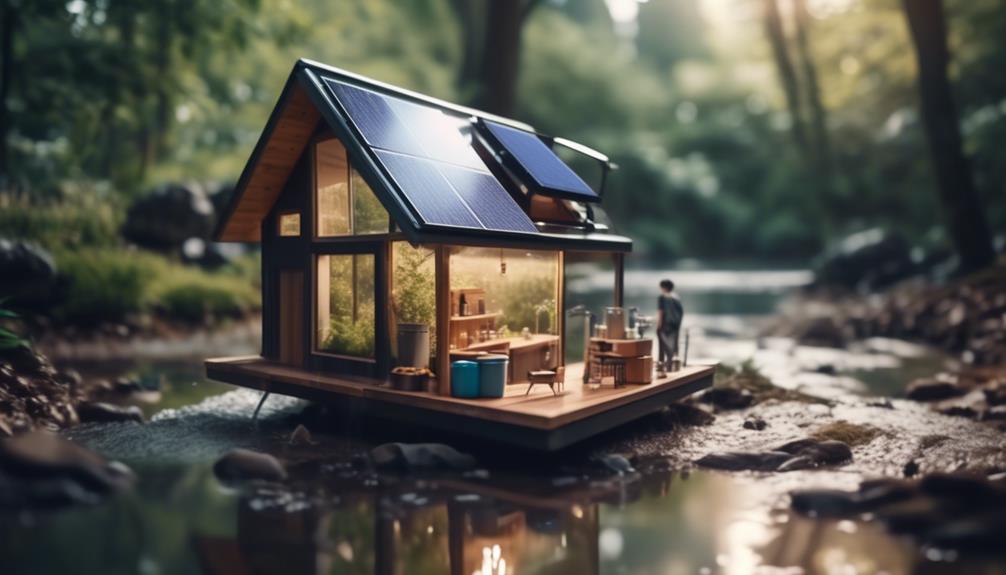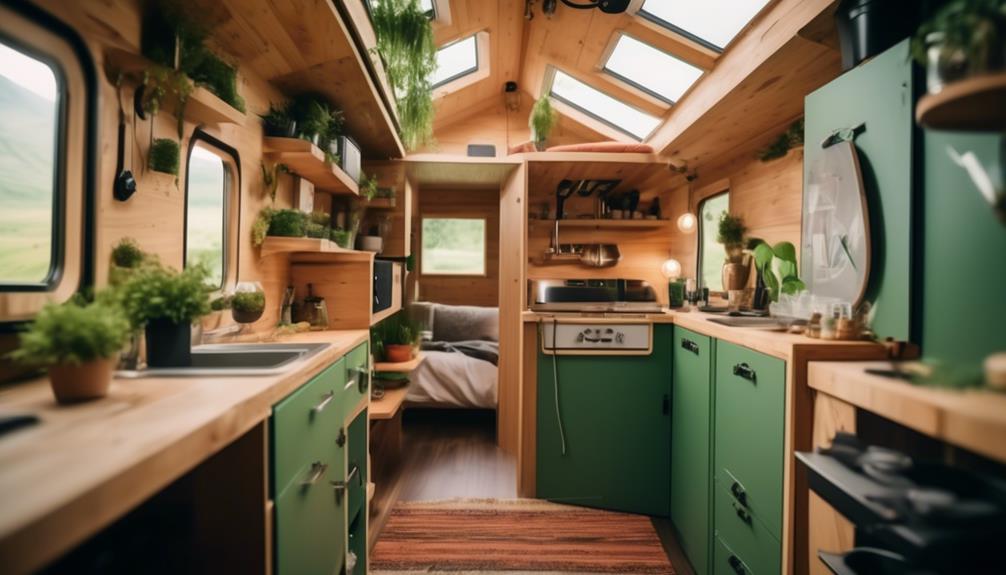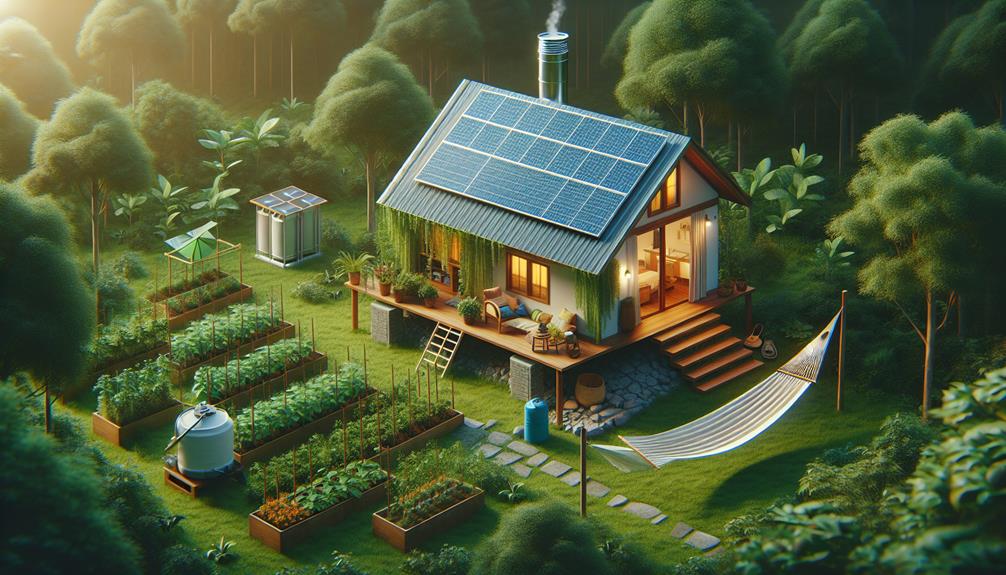You might believe that living in a tiny home off-grid means sacrificing comfort, but with the right preparations, you can enjoy a surprisingly rich and convenient lifestyle.
It's about understanding the essentials, from choosing a location that meets your needs to implementing renewable energy sources that keep your carbon footprint low.
You'll need to think about how you'll collect and purify water, the most effective strategies for waste management, and how to make the most of every square inch without feeling cramped.
And as the seasons change, so will your approach to maintaining comfort and efficiency.
Stick with me, and I'll guide you through the considerations and practical tips that can turn this dream into a sustainable reality, ensuring you're well-equipped for the journey ahead.
Key Takeaways
- Consider location factors such as climate, zoning laws, access to water, and sunlight for sustainable off-grid living.
- Implement sustainable energy solutions like solar power and renewable energy sources to meet energy needs.
- Utilize effective water collection and purification techniques to ensure a sustainable water supply.
- Adopt waste management strategies like composting and recycling to minimize environmental impact in a tiny home.
Choosing the Right Location
Selecting a sustainable spot for your off-grid tiny home involves considering the local climate, understanding zoning restrictions, and ensuring access to vital resources like water and sunlight.
You'll want to research if the areas have zoning laws that support your off-grid aspirations. You must ensure your water supply is reliable—well water is an option, but you'll need to verify the water is safe for consumption. Moreover, harvesting rainwater is a popular method to stay self-sufficient. Access to sunlight is crucial, not just for solar power, but to help regulate the temperature inside your home, reducing your environmental impact.
Always plan in case of emergencies and stay safe by assessing the proximity to amenities. Keep in mind the challenges of living off-grid and prepare accordingly. Your innovative spirit will thrive with the right groundwork.
Sustainable Energy Solutions
Harnessing the power of the sun, solar panels offer a reliable and eco-friendly energy solution for your off-grid tiny home. By integrating a full solar panel system, you're not only tapping into renewable energy sources but also paving the way for a sustainable lifestyle. Properly installed on your roof, these panels ensure that your energy needs are met, even when you're miles away from the grid.
But it's not just about electricity—consider how solar power can support your water filtration and purification systems. And don't forget, composting toilets are an excellent complement to your eco-conscious setup, minimizing waste and water usage.
Water Collection and Purification

After outfitting your tiny home with solar panels for energy independence, it's essential to consider how you'll secure a clean water supply through effective collection and purification techniques. Living off the grid in a tiny home requires innovative strategies to be self-sufficient, especially regarding water.
Here are three crucial methods to ensure a sustainable water supply:
- Rainwater Harvesting: Install gutters to collect water from your roof, directing it into storage tanks. This water, primarily used for non-potable purposes, can reduce your dependence on external sources.
- Purification Systems: Equip your off-grid tiny home with a filtration system to purify rainwater for safe drinking and cooking.
- Natural Sources: When available, use water from nearby springs or streams, but always apply purification methods to protect against contaminants.
Waste Management Strategies
To maintain an eco-friendly lifestyle in your tiny home, it's vital to implement a robust waste management system that reduces your environmental footprint. Living in a tiny space necessitates innovative storage solutions and a commitment to minimizing waste. Off-grid living brings the benefits of living closer to nature, but it also requires you to be more conscious about your waste.
| Waste Type | Management Strategy | Tiny Home Benefits |
|---|---|---|
| Organic Waste | Waste into compost | Used as fertilizer, reduces trash |
| Recycling | Upcycling, storage solutions | Minimizes environmental impact |
| Human Waste | Composting sewage system | Eliminates need for traditional sewage |
Tiny houses call for a creative approach to waste. By turning waste into compost, you not only enrich your garden but also cut down on the need for chemical fertilizers. Remember, every small step you take can lead to a greener planet.
Space Maximization Techniques

While managing waste effectively is a cornerstone of sustainable tiny home living, making the most of your limited space is equally essential for a harmonious off-grid lifestyle. Tiny home living demands creativity to maximize your living space. Here are space maximization techniques to help you design and build a more efficient home:
- Choose multi-functional furniture, like a desk that transforms into a dining table, to utilize every inch of your limited space.
- Opt for built-in storage solutions that make use of vertical space and keep your living areas clutter-free.
- Install large windows to usher in natural light, creating an illusion of a larger space while reducing the need for artificial lighting.
Make sure to incorporate these strategies to maintain an organized, spacious tiny home environment.
Seasonal Living Adjustments
As seasons shift, you must adapt your tiny home's heating and cooling to stay comfortable without wasting energy. You'll need to manage resources wisely, employing energy-saving strategies during peaks of heat or cold and adjusting water use as weather dictates.
Seasonal food storage and smart gardening choices also ensure you live sustainably and in harmony with the natural cycles.
Adapting to Climate Changes
Living in an off-grid tiny home requires you to keenly adapt your lifestyle to the seasons, ensuring your comfort and sustainability throughout the year. Tiny home living means less energy consumption, but maintaining a comfortable temperature can be a challenge. Here are a few tips and tricks:
- Solar Power System: Optimize the angle of your solar panels seasonally to maximize energy absorption, especially during winter when sunlight is scarce.
- Water Management: Collect and store water during the rainy season, and practice conservation during dry spells to extend your reserves.
- Insulation: Enhance your tiny house's insulation before the cold sets in, and consider shade solutions for the summer to keep your space cool.
Tiny homes require innovative thinking, so be proactive in adapting to the ever-changing climate.
Seasonal Resource Management
To optimize your off-grid tiny home experience, you'll need to adjust your resource management with the ebb and flow of the seasons. This includes managing energy consumption, water use, and food preservation.
First, your solar power system should adapt to the varying solar intensity throughout the year. In summer, focus on reducing the amount of energy needed for cooling by leveraging natural ventilation. In contrast, during winter, prioritize insulation to retain heat.
Water storage solutions must also account for seasonal rainfall to ensure you don't deplete your reserves. It's important to be proactive with your supplies as you're living off-grid. This means growing and preserving food and managing waste.
Living off-grid offers options that surpass traditional utilities connected to the grid and grants you a harmonious, sustainable lifestyle.
Frequently Asked Questions
How to Live Off-Grid Tiny House?
To live off-grid in a tiny house, you'll need solar solutions, water harvesting, and solid waste management. Master energy storage, embrace a minimalist lifestyle, and learn permaculture gardening for self-sufficiency. Scout locations carefully!
How Do Beginners Live off the Grid?
You'll start by embracing sustainable energy, like solar, and learning water harvesting. Master composting toilets, understand land zoning, and dive into food cultivation. Adopt waste management, network within the community, and explore bartering and solar cooking.
How Much Does It Cost to Build a Tiny House off the Grid?
You'll spend $10,000 to $100,000 on your off-grid tiny house, factoring in land acquisition, permits, material costs, and sustainable insulation. Solar solutions, rainwater harvesting, and energy storage are key for self-sufficiency.
How Do I Prepare to Live in a Tiny House?
To prepare for tiny house living, you'll need to embrace space optimization and minimalist lifestyle. Master downsizing strategies, utility planning, and storage solutions. Ensure legal considerations are met and design for climate adaptation. Get emotionally ready.
Conclusion
As you stand on the precipice of untamed freedom, remember that your off-grid tiny home is more than a dwelling—it's a statement.
Harness the sun's power, cherish each raindrop, and turn waste into a resource.
Your space may be small, but your impact is mighty. Embrace the seasons, adapt, and thrive.
The world awaits your sustainable footprint. Take that step, the journey is as green and vibrant as the life you're about to cultivate.

